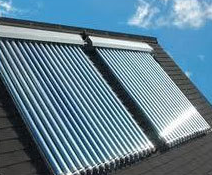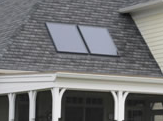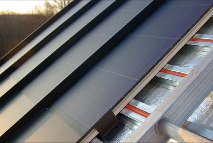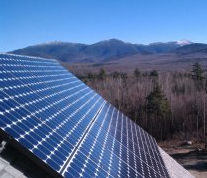I’m sitting inside on a cloudy day and I can feel the cold air that creeps across my floor, enveloping my stockinged feet. If the sun came out, I could turn off my desk lamp and bask in the sun’s warmth and light. The benefits of the sun are so basic, yet not something that’s always thought about when designing a house.
In a previous post, “Site Evaluation”, I talked about the importance of solar orientation for the house and the placement of the rooms inside it.
This post is devoted to the sun itself and how to take advantage of its warmth and power. The sun can be used in three basic ways: provide space heating, water heating, and electricity. The benefits are: reduced consumption of fossil fuels and therefore a smaller carbon footprint and saving money.
SOLAR OPPORTUNITIES FOR HOUSES

Solar Evaluation
A solar site evaluation by an experienced solar equipment installer will determine whether or not a solar energy investment makes sense. They will be looking at roof pitch, roof orientation, shading issues, and heating system compatibility.
Bear in mind that in Maine, solar energy by itself will not provide 100% of the space heating and domestic hot water that is needed. Back-up systems will be required.
But hold on! Before any effort and money are put into the benefits of “going solar”, you need to size up your current housing situation. Chances are, your existing home is wasting energy in ways you never imagined and until you get a handle on where and how this is happening and do something about it, you’re wasting your time on contemplating solar. Only an energy audit can discover such things. Air sealing and insulating are by far the most cost effective strategies to employ first. Your comfort will increase and your heating bills will decrease.
If you are having a new house designed, insist that the architect’s scope of work include an energy model. This is a computer simulation of the house’s windows, walls, roof, and foundation and how they perform in a specific climate. The computer energy model factors in air infiltration (how leaky the house is) as well. The beauty of this tool is that you can try different levels of insulation, different window glass, and different rates of air infiltration to find out the best combination (usually based on length of payback for the added investment).
Assuming you’ve made the investment to minimize the current demands for heat in your existing house or have a design for a new house that is really energy efficient, then you can look seriously at solar strategies.
Solar Space Heating
Heating the interior of a house with the sun takes two forms: Passive Heating and Active Heating. Both are best suited to new construction since most older homes, even after an energy retro-fit, are still not energy-efficient enough to justify the investment.
Passive Solar Space Heating Systems
Passive systems for heating are simple in concept and have few if any moving parts. The idea is to trap solar radiation within the building during the day and store enough of it to keep the building warm during a cold winter’s night. The two basic elements you need are: south-facing glass and something to absorb and store all that heat after it has entered the house. The two most common materials for storing heat are masonry and water. Typically, for this to work, one-half to two-thirds of the total surface area in a south-facing room has to be built of thick masonry, or the house will overheat. Hmmm, it’s a bit daunting for most homeowners to contemplate a house with so much exposed masonry or concrete on the interior. A scaled-back version with perhaps a concrete floor or stone wall and not so much glass is more likely. In either case, it has to be part of every step in the building’s design from the initial concept. Another concern is night-time heat loss through the glass. Thermal window treatments to cover the glass at night is a good idea (even if you don’t have a passive solar heating system).
Active Solar Space Heating Systems
Active solar space heating systems use hardware and electrical energy to collect and distribute heat. The major elements are: a ground or roof-mounted solar collector, a separate water storage unit, and a low temperature distribution system, like radiant floors. Unlike passive systems, these systems can be more easily incorporated into new construction. But, like anything that is added to the house, the more you plan in advance, the better it will look and work.
Solar space heating makes the most sense in a new, air tight, well-insulated home where the heating load (amount of heat required over the course of a year) is brought down to a very low level.
Active solar space heating systems typically use roof-mounted or ground-mounted solar collectors that look like this:
Evacuated tube

Flat plate collector

Solaris Thermal
If you are considering a standing seam metal roof, then another option is to integrate the collection system with the roof covering so the entire south-facing roof system becomes the solar collector. The tubes are hidden beneath the metal roof cladding. As a hybrid system, the metal panels can also be covered with a thin film PV laminate to generate electricity. Pretty slick from an architectural point of view, though not as efficient and more expensive then roof-mounted systems.

Dawn Solar
Solar Domestic Hot Water Heating Systems
This is the solar option that makes the most economic sense for new and existing homes. Up to 80 – 90% of the domestic hot water used annually can be generated from the sun using solar collectors. They are compatible with existing water heating systems. Like the active space heating systems, the collectors are either flat plate design or evacuated tube design. The heavily insulated hot water storage tank has two coils – one for the solar collectors and the other as a backup from the boiler. What’s nice is that, in Maine, when visitors start showing up in the summertime, this is when the solar collectors produce the most hot water!
Solar Electricity
Solar electric panels make electricity directly from sunlight. Even though the panels continue to get cheaper and cheaper, the installed costs are still high. But thanks to government rebates and tax credits, the systems are becoming more affordable and cost effective. The simplest and least expensive systems are tied to the electrical utility grid. The grid acts as a bank where you deposit excess electricity on a sunny day when you produce more than you consume and where you draw power when the solar electric panels aren’t producing enough.
Photovoltaic potential varies widely across the country from 7 kWh per square meter in the Southwest to 4 kWh per square meter in New England.
There’s a website I highly recommend for anyone interested in finding out more about solar energy and how to go about making it work for you:

Revision Energy
